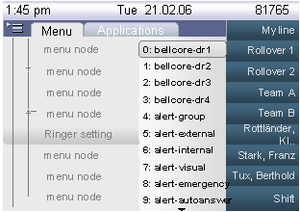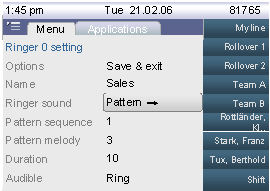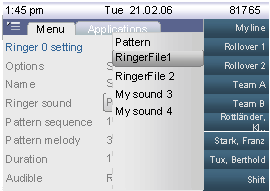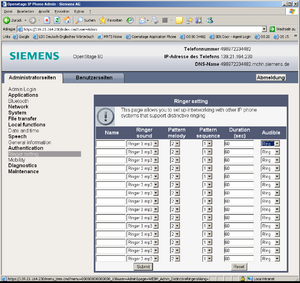Distinctive Ringing SIP Administration
The Wiki of Unify contains information on clients and devices, communications systems and unified communications. - Unify GmbH & Co. KG is a Trademark Licensee of Siemens AG.
| Systematics | |
| Family: | OpenStage |
| Model: | OpenStage 60 OpenStage 80 |
| Relation: | SIP related |
| Release: | V2 R0 |
The SIP Server may provide information within an incoming call indication or ringer request that the call is of a particular type. This indication can be used by the phone to determine what sound the ringer makes. A list of different ring types is maintained in the phone.
Any ringer sound may either be
- Constructed (from melody and tone sequence settings)
- Audio file (selected from the pool of ringer files on the phone)
New SIP Functionality
- User has a standard ringer sound that they can configure (sequence melody and optional) ring tone file (current behaviour).
- Admin can configure further distinctive ringers that are triggered in place of the standard ringer if the phone receives a matching Alert info identifier in the SIP signalling for a call (new behaviour).
Triggering distinctive ringing
For SIP the SIP Alert-info header is used to pass an identifier string that is match to the table configured on the phone. The matched entry indicates the ringing to be used for the call. The ringing may be constructed or from an audio file. Admin is responsible for ensuring that the distinctive ring names specified on the phone are coordinated with the SIP server. The distinctive ringing feature does not apply to SIP call waiting calls.
In all cases if a distinctive ring is requested then the associated ring type is used instead of the default ringer.
If distinctive ringing is not requested or cannot be matched to a ringer then SIP - the default ringer is used.
Distinctive ringer naming
For SIP the names of the distinctive ringers are configurable by Admin who are responsible for ensuring that the distinctive ring names specified on the phone are coordinated with the SIP server.
The administration menu will require a new node Admin > Ringer setting; providing a context menu to the tree node that allows one of the available ringers to be selected by name. The UI will present a list of 15 ringers. Unnamed ringers will be shown, and the name will be blank.
Opening a ringer will present a form which allows constructed tones or audio files to be specified as the sound for that ringer, the form will support browsing and preview of ringer sounds. The number of the ringer being viewed/modified will shown at the top of the form. See the following screens for examples of the ringer form.
When a ringer is being defined the form will offer several editable settings:
- Name: Input box set to alpha mode (SIP only - for HFA the Name is displayed but read only).
- Ringer sound: Enumeration (Pattern or the name of the selected ring tone file), see Ringer Sound Menu option below.
- Pattern Melody: Enumeration (choice) 1 to 8.
- Pattern sequence: Enumeration (choice) 1 to 3.
- Duration: Input box set to numeric. The preferred style for entering values is an enumeration (set of choices), but for compatibility with Optipoint and DLS the range for this value is any in-teger between 0 and 300 seconds. As such the number must be directly entered into this field.
- Audible: Shown only for SIP, Enumeration (choice of Ring or Silent). Can be set to silent to give visual indication only. This form item is not shown on HFA.
| Ringer Sound Menu option | Option action |
|---|---|
Pattern
|
Sets the distinctive ringer to use the currently set pattern (mel-ody and sequence). This is the pattern that will be used of the configured ring-tone file cannot be played for any reason. |
<audio file 1>...<audio file n>
|
Sets the distinctive ringer to use the selected ring tone file in-stead of the pattern. |








